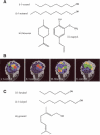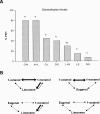Olfactory blocking and odorant similarity in the honeybee
- PMID: 15805307
- PMCID: PMC1074325
- DOI: 10.1101/lm.79305
Olfactory blocking and odorant similarity in the honeybee
Abstract
Blocking occurs when previous training with a stimulus A reduces (blocks) subsequent learning about a stimulus B, when A and B are trained in compound. The question of whether blocking exists in olfactory conditioning of proboscis extension reflex (PER) in honeybees is under debate. The last published accounts on blocking in honeybees state that blocking occurs when odors A and B are similar (the "similarity hypothesis"). We have tested this hypothesis using four odors (1-octanol, 1-nonanol, eugenol, and limonene) chosen on the basis of their chemical and physiological similarity (experiment 1). We established a generalization matrix that measured perceptual similarity. Bees in the "block group" were first trained with an odor A and, in the second phase, with the mixture AB. Bees in the "novel group" (control group) were first trained with an odor N and, in the second phase, with the mixture AB. After conditioning, bees in both groups were tested for their response to B. We assayed all 24 possible combinations for the four odors standing for A, B, and N. We found blocking in four cases, augmentation in two cases, and no difference in 18 cases; odor similarity could not account for these results. We also repeated the experiments with those six odor combinations that gave rise to the similarity hypothesis (experiment 2: 1-hexanol, 1-octanol, geraniol) and found augmentation in one and no effect in five cases. Thus, blocking is not a consistent phenomenon, nor does it depend on odor similarity.
Figures





Similar articles
-
The effect of similarity between elemental stimuli and compounds in olfactory patterning discriminations.Learn Mem. 2002 May-Jun;9(3):112-21. doi: 10.1101/lm.41002. Learn Mem. 2002. PMID: 12074999 Free PMC article.
-
Variation in complex olfactory stimuli and its influence on odour recognition.Proc Biol Sci. 2004 Jan 22;271(1535):147-52. doi: 10.1098/rspb.2003.2590. Proc Biol Sci. 2004. PMID: 15058390 Free PMC article.
-
Odor discrimination in classical conditioning of proboscis extension in two stingless bee species in comparison to Africanized honeybees.J Comp Physiol A Neuroethol Sens Neural Behav Physiol. 2007 Nov;193(11):1089-99. doi: 10.1007/s00359-007-0260-8. Epub 2007 Aug 21. J Comp Physiol A Neuroethol Sens Neural Behav Physiol. 2007. PMID: 17710409
-
Categorization of visual stimuli in the honeybee Apis mellifera.Anim Cogn. 2006 Oct;9(4):257-70. doi: 10.1007/s10071-006-0032-9. Epub 2006 Aug 15. Anim Cogn. 2006. PMID: 16909238 Review.
-
A componential view of configural cues in generalization and discrimination in Pavlovian conditioning.Behav Brain Res. 2000 Jun 1;110(1-2):67-72. doi: 10.1016/s0166-4328(99)00185-0. Behav Brain Res. 2000. PMID: 10802304 Review.
Cited by
-
Application of a Prediction Error Theory to Pavlovian Conditioning in an Insect.Front Psychol. 2018 Jul 23;9:1272. doi: 10.3389/fpsyg.2018.01272. eCollection 2018. Front Psychol. 2018. PMID: 30083125 Free PMC article.
-
Behavioral and neural analysis of associative learning in the honeybee: a taste from the magic well.J Comp Physiol A Neuroethol Sens Neural Behav Physiol. 2007 Aug;193(8):801-24. doi: 10.1007/s00359-007-0235-9. Epub 2007 Jul 17. J Comp Physiol A Neuroethol Sens Neural Behav Physiol. 2007. PMID: 17639413 Review.
-
Smells like home: Desert ants, Cataglyphis fortis, use olfactory landmarks to pinpoint the nest.Front Zool. 2009 Feb 27;6:5. doi: 10.1186/1742-9994-6-5. Front Zool. 2009. PMID: 19250516 Free PMC article.
-
Multi-modal cue integration in the black garden ant.Anim Cogn. 2020 Nov;23(6):1119-1127. doi: 10.1007/s10071-020-01360-9. Epub 2020 Feb 19. Anim Cogn. 2020. PMID: 32076920
-
Appetitive floral odours prevent aggression in honeybees.Nat Commun. 2015 Dec 22;6:10247. doi: 10.1038/ncomms10247. Nat Commun. 2015. PMID: 26694599 Free PMC article.
References
-
- Allen, M.T., Padilla, Y., and Gluck, M.A. 2002. Blocking in rabbit eyeblink conditioning is not due to learned inattention: Indirect support for an error correction mechanism of blocking. Integr. Physiol. Behav. Sci. 37: 254-264. - PubMed
-
- Arcediano, F., Matute, H., and Miller, R.R. 1997. Blocking of pavlovian conditioning in humans. Learn. Motiv. 28: 188-199.
-
- Batsell, W.R. 1996. Retention of context blocking in taste-aversion learning. Physiol. Behav. 61: 437-446. - PubMed
-
- Batsell, W.R. and Batson, J. 1999. Augmentation of taste conditioning by a preconditioned odor. J. Exp. Psychol. Anim. Behav. Proc. 25: 374-388. - PubMed
-
- Batsell, W.R., Paschall, G.Y., Gleason, D.I., and Batson, J.D. 2001. Taste preconditioning augments odor-aversion learning. J. Exp. Psychol. Anim. Behav. Proc. 27: 30-47. - PubMed
Publication types
MeSH terms
Substances
LinkOut - more resources
Full Text Sources
Other Literature Sources
